Seamless steel pipes have no obvious welds during the manufacturing process because they are formed by overall heating and rolling. However, weld seam preparation is usually a step in the production of steel pipes related to welding, especially for steel pipes made by welding, such as long welded seam steel pipes. The following are some steps and methods for welding seams.

Weld Seam Cleaning:
After welding is completed, the weld seam needs to be cleaned to remove oxides, welding slag and other impurities produced by welding. This can be done by mechanical means (such as scraping or grinding) or chemical methods (such as pickling).
Weld Smoothness:
The welding process may produce uneven surfaces that need to be ground or polished to ensure the smoothness of the weld. This improves the cosmetic quality and overall surface smoothness of the weld.
Stress Relieving Heat Treatment:
Residual stresses are introduced during the welding process. In order to reduce these stresses and improve the stability of the weld, stress relief heat treatment can be performed. This includes reheating and cooling the weld area to relieve residual stresses.
Weld Hardness Testing:
Hardness testing of welds is a common quality control step. Hardness testing can detect the presence of abnormal hardness in the weld to evaluate the quality of the weld.
Ultrasonic Testing:
Ultrasonic testing is a non-destructive testing method used to detect internal defects in welds, such as pores, inclusions, etc. This helps ensure welding quality and reliability.
Anti-Corrosion Treatment:
For some applications, especially in corrosive environments, it may be necessary to anti-corrosion treatment of welds, such as coating with anti-corrosion paint or using other anti-corrosion measures, to extend the service life of the pipeline.